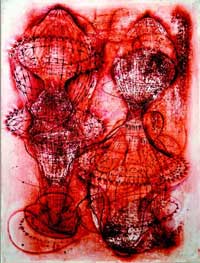
Color Me Bored / Color Me Glad
Colored Pencil at KS Arts; Lori Bookstein’s stable
By Maureen Mullarkey
Gallery-trippers addicted to recreational depression can get
their fix at KS Arts. Sixty nine colored pencil drawings are
hung delicatessen style to fit as many names as possible. A
scattering of good things struggles to assert itself in the
face of militant banality.
 |
| "Fictional Antiquities" by Stephen Talasnik |
Thomas Nozkowksi and Red Grooms lend tone to the event. Grooms
puts pencil to work with trademark intensity but his raucous,
hard-boiled humor gets lost in the clutter. Nozkowski’s
quirky elegance hangs over head to make room for dirty drawings
at eye level.
Philip Knoll draws the short straw for winsome indecency. Priapic
little fellows, sweetly outlined in pale yellow, frolic across
a tender pink ground, penetrating each other’s various
orifices. Knoll is a careful draftsman with an imagination stalled
in the promiscuity that inspired—and killed—Keith
Haring. Mr. Knoll’s deceptively childlike daisy chain
needs a surgeon general’s warning.
Colored pencil encourages doodling. Grab a ready-made spectrum
and have at it. May a thousand cartoons bloom. And so they do,
some of them quite clever. Elliott Green is inventive and draws
with a firm hand. But to signal that this is a put-on, he surrounds
his improvisation with a cheesy faux-gilt frame. A finger in
the eye to you, dear viewer.
There is more that one way to batter an audience. Jim Shaw does
it by smacking a four-figure price tag onto spidery musings
across a paper napkin. Polly Apfelbaum does it with a quartet
of listless scratchings that pretend to orphic significance.
Sara Jessie Kane pins hers haphazardry to the wall, much the
way her mother, with pride and wonder, used to hang her stuff
on the refrigerator.
Un-art is a genre you can bypass without second-guessing yourself.
Bad art well executed is more misleading. The pointless virtuosity
of Mark Greenwold and Julia Randall illustrates the distinction
between technical knowledge and a raison d’etre worth
the effort of technique.
Mr. Greenwold’s “Lucy” serves up three sour
portraits in a hermetic interior. Over each disagreeable head
hovers a penciled proxy for a comic book dialogue balloon. The
device implies an intended narrative (complaint, probably) rendered
mute by the vapidity of the caricature. Ms. Randall combines
fastidious technique with arbitrary sight-gags. A large bird,
perched on a perfume bottle atomizer, is limned in sensitive
detail. Instead of a head, the body ends in a grotesque mouth
blowing a saliva bubble. Think Audubon on crystal meth. Both
artists, like others on show, beckon to spectators high on free-associative
dead ends.
Watch for Sid Garrison’s sensuous abstraction, Susan Jennings’
delicate study of wood grain and Mark Grotjahn geometric designs
converging on a strict axis. Add to these Stephen Talasnik’s
“Fictional Antiquities” (2002). Using sanguine on
heavily worked paper, he exploits the character of pencil with
admirable elán, creating something distinctive and beguiling.
On balance, color me bored.




A very different kind of ensemble hangs at Lori Bookstein Fine
Art. The gallery debuted in new midtown digs with a sampling
of its contemporary stable plus a selection of earlier modernists.
With only one piece from each artist, a certain staccato quality
to the installation is inevitable. But that is okay in a tasting
menu that gives you the flavor of the house. The exhibition
coheres around the gallery’s commitment to American painting
. Special emphasis is on American modernism and the legacy of
Hans Hofmann. Expect fine color handling in a variety of idioms,
from traditional to abstract.
 |
| Ken Kewley; from "Dressing Room" series |
The Hofmann connection is handsomely represented by Paul Resika,
Jan Müller, Bob Thompson and Aristodimos Kaldis. Robert De
Niro, Sr., the least substantial of the group, is also aboard.
Louis Finkelstein and Walter Buckner are pleasurable companions,
each using color to arrive at their own species of pictorial
space. Ignoring chromatic range in favor of the tonal satisfactions
of the gray scale are Susannah Phillips and Gerald Auten.
Before Hofmann there was Arthur B. Carles, one of the most dynamic
of the elder American modernists. “Landscape through a
Window” (c. 1908-12), is too small and too early to convey
the excitement and character of his achievement. Still, be glad
the gallery has access to his work and, presumably, will exhibit
more of it. Marsden Hartley, Alfred Maurer and Ralph Albert
Blakelock, possibly the most imitated (and forged) of all American
painters, are also on view.
Arnold Friedman is not exhibited often enough. There is a strange
poetry to his painting that comes from modesty before his motifs
in tension with a distinguished color sense and deliberated
brushwork. His “Woman in a Brown Dress” (c. 1930-32),
a subtle harmony of browns and greens, is a pleasure to find.
This is not the place for tracking the batting averages of art
stars. Gallery preferences tend toward gifted practioners who
keep producing and perfecting their craft without regard to
fashion. And without looking over their shoulders to see which
names are gaining on them. Sculptors Louise Kruger and Bruce
Gagnier are among these. Ms. Kruger, once apprenticed to a ship
builder, combines command of joinery with a keen sense of form.
Her tulip wood “Figure of Man,” rounded like a ripe
seed pod, is a whimsical complement to Bruce Gagnier’s
unsettling “Otoma,” whose stressed musculature is
weighted with anxiety.
Do not miss the three collagists. Ken Kewley, a vivacious colorist,
abstracts from visual experience with a scope greater than his
miniature format suggests. Henry Rothman and Janet Malcolm are
more cerebral, constructing illusory space out of abstract elements.
Each one, in quite different ways, achieves a spatial cohesiveness
that is deeply gratifying.




“Colored Pencil” at KS Art (73 Leonard
Street, 212.219.1489).
“Group Show 2004” at Lori Bookstein Fine Art (37 West 57 Street, 212.750.0949).
A version of this review appeared in The New York Sun, April 29, 2004.
©2004 Maureen Mullarkey







